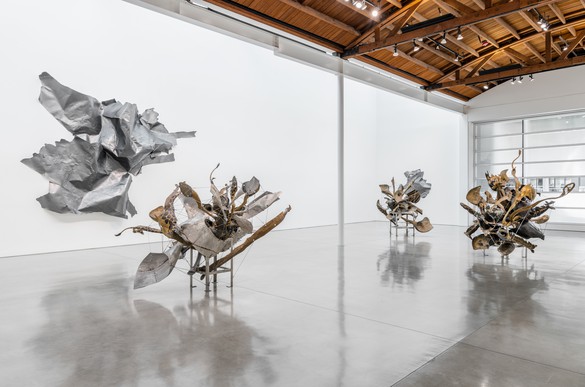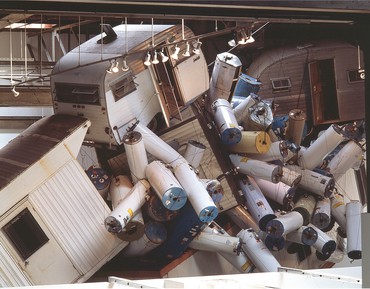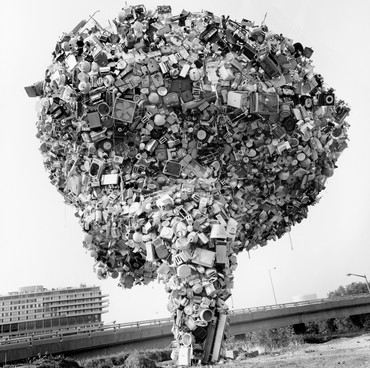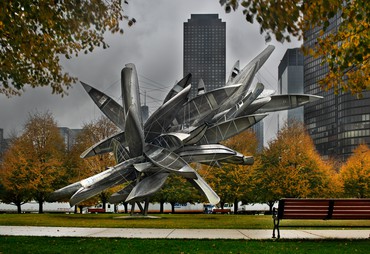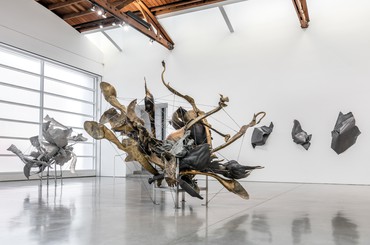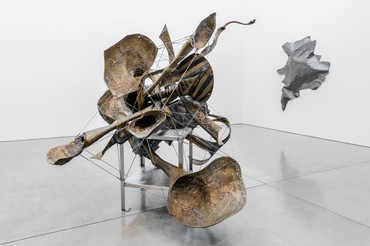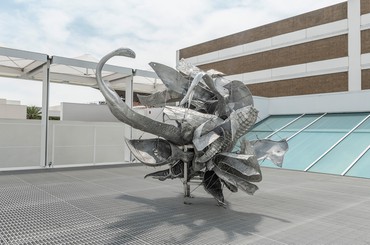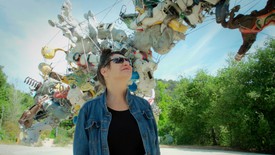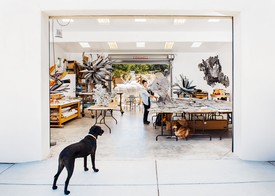
Sara Softness is an interdisciplinary curator and writer based in Brooklyn. She is currently at work on an exhibition debuting at the Museum of Jewish Heritage—A Living Memorial to the Holocaust, New York, in October 2021. She previously served as director of the Walther Collection Project Space and assistant curator of special projects at the Brooklyn Museum. Photo: Dora Somosi
It’s been a banner year for the study of monuments. Politically catastrophic, ongoing popular unrest, a deadly pandemic—such “unprecedented times” have unleashed unfettered, angry attention onto, broadly speaking, power: who has it, who abuses it, and how it makes itself known. Indeed, traditional monuments, those of granite and bronze and valor, can say a lot about how power operates, from the municipal councils that approve and fund them to the culture at large. Such statues, plaques, and markers, occupying our most public convening spaces and designed to be permanent, are values writ large, historical conclusions drawn in physical form.
Monuments are a self-conscious reflection on time; their use value is in speaking from past to present to future. And making public monuments is a priority for those in power precisely because it helps them justify and validate a power they know to be fickle. In other words, it is because everything changes so constantly that monuments seek to freeze time, finding ways to carry what’s important through history. This could be a neutral truth, a force for good as much as bad. One problem, on either pole, is that time-traveling monuments are woefully inadequate at distilling much of anything besides a glorified party line; they are the figuration of hegemony. Inevitably, as a mechanism for explaining or embodying history, they fail to capture any degree of multiplicity—any inkling of the niggling complexities inherent to our human scale. I think with literality of the term “larger than life”—but isn’t a little life what we’re after?
Works from Nancy Rubins’s Fluid Space series (2019–21), installed at her studio, Topanga, California, 2021. Video: Brian Guido, Mike Schwartz, and John Bowers
Enter Nancy Rubins. Rubins knows from larger than life. In their most recognizable form, her artworks comprise enormous sculptures soaring 40 or 50 feet high, built out of heaps of stuff smashed together: entire trailers, water heaters, airplane parts, canoes, kayaks, rowboats, playground equipment, and lawn animals, with jutting edges cantilevered as if suspended. They bloom like lithe industrial bouquets of scrap metal and salvaged detritus, finding exquisite and unexpected equilibriums. They have a kind of inevitability to them, an inherent logic that is totally satisfying, a little bewildering, and more than a little bold—as if no one mentioned to Rubins the inadvisability of tinkering with such hulking and inflexible materials. When I first saw an image of MoMA and Airplane Parts at Forte Belvedere, Florence, Italy (2003), I read its existence with this very mixture of awe—how did she do this?—and what I imagined to be her own defiance: who says I can’t?
In the lead-up to writing this piece, during a wonderful, monthslong conversation with Rubins over Zoom, I’d had in mind, given the pressing political relevance, to think about Rubins’s work—its colossal scale, its frequently public siting—as sorts of untraditional monuments. Her early works—hordes of small domestic appliances like TVs, blow-dryers, toasters, radios, razors (and on and on) that she collected and formed into giant tidal waves—suggest memorials of a kind, or, at the least, somewhat grim American portraits. I’d then read about the grassroots organizing in Mexico City around “antimonumentos,” in which activists are erecting homemade markers to commemorate tragedies either forgotten—or perpetrated—by the state. These actions are guerrilla-style political sit-ins, demonstrations that adopt the meaning-making memorial language of monuments, but are concerned less with their visual and stylistic impact than with the social gesture and statement. Antimonumentalism, a bona fide philosophy in art, indeed recants the permanence, obstinacy, and inaccessibility of conventional monuments as instruments of official power, favoring oppositional techniques and strategies that expose under-known histories. (A close cousin is, of course, institutional critique, the province of conceptual artists from Hans Haacke to Taryn Simon.) Perhaps Rubins’s project, salvaging from the junk pile and mining a material archive, would be right at home here.
But that is not Rubins. She works monumentally, but makes neither monuments nor antimonuments. In my monuments fever, my misguided appetite to place her work in this conversation, I unwittingly enacted an instance of the misses-the-point interpretative overlay that Rubins has fended off for decades in one way or another. Some frequent readings regard her work as a critique of capitalist consumption, an expression of environmental disaster, or a feminist reproach of domesticity. (“I don’t think of myself as having a feminist practice, or even a practice that otherwise prescribes meaning or messages,” she has said.) To really make sense of Rubins’s ecstatic and one-of-a-kind ambitions, I had to listen. So I did. I was privileged to have her passionate explications at my disposal, which challenged me to slow down enough that I might decolonize my own tendency to make everything into a monument that draws a conclusion. It was in completely rejecting the monuments framework, in embracing a true conceptual abstraction, not just a literal one, that I could really see and understand Rubins’s art making. And while I admit to more than a little discomfort with this open-endedness, these fluid spaces, I’m certain this exercise has made me a better art historian.
A formalist, Rubins is concerned with and thrilled by her materials and the marks they can make in space. Over the course of our conversations, she brought up Paul Cézanne more times than I could count—a reference to the ultimate practitioner of pure medium in abstracted form. Richard Serra, pushing steel to its limits, was likewise invoked. Whether it’s oil paint, steel, or, in her case, salvaged objects and metals, Rubins is obsessed by how things work, how they are built, what they are made from, and how all of those elements can be exploited to create new forms. She has, I think, the soul of an engineer. She shared a formative memory of visiting the Statue of Liberty as a child, examining the bolts and facets from the inside and marveling at how different the sculpture appeared from the interior versus the exterior. Consider that each element in her sculptures possesses myriad material qualities to appraise: size, weight, mass, volume, angle, texture, curvature, surface, balance, color, patina, chemical makeup, integrity, pliability, durability, light, shadow, and on and on. And Rubins vastly compounds these concerns with her multiply intersecting accretions, whose gravity-defying suspension structure requires further consideration. Add to this that each work can be viewed from multiple angles, and it is clear that Rubins is not only a proud formalist, but a busy one. It didn’t matter whether Cézanne painted an apple or a walrus; it was how he did it that was so transformative. It is the same for Rubins. As an artist, she does not intend to hold forth on boats qua boats, so much as to electrify their form—which she does, brilliantly.
Perhaps the most revealing comment that Rubins made during our conversations was when she described her reaction, while visiting a museum, to seeing a small chisel mark in a piece of ancient pottery. She said that it sent chills down her spine. This was the moment I saw the monument fall away in my mind’s eye; I saw that Rubins seeks not to make the Great Sphinx, but to scratch out the universally understood divot, the smudge that speaks of its human maker all those millennia ago. Indeed, her works are not symbols or signs of something else. They don’t point outward, suggest a story, or signal importance; they don’t “make a mark,” so much as they are mark making. They are their own containers, which, in their pulsating creative energy, aspire to the same pathos of the ancient chisel mark. Rubins has remarked that we don’t need art for survival, but it is what makes us human. Unmediated by the historian’s interpretations, the curator’s expertise, the trivia and facts and dates, that mark is a meditation on time, on all those who came before, on materials, on how everything changes but in so many ways humans stay the same. It’s a pure state of discovery, a jolt, and a thrill. Rubins’s magic is to scale up the chisel mark.
How? For one thing, her materials represent a kind of archaeological gray space, where an object’s age, origins, and utility are rendered irrelevant. And with the exception of her most recent body of work, Fluid Space (2019–21), Rubins does not alter her materials to fit or hinge or lever in a certain way. Secondly, she begins her process with admiration. When she described working with airplane parts for the first time, she mentioned being blown away by how exquisite each piece of metal was. This was not a mere turn of phrase; it was obvious she was quite moved. (I understood this intellectually but am certain that I could never feel the same way, likely because I can’t not see a jagged old airplane part.) From this admiration, Rubins sees and channels formal potential. That’s a transformation that only an artist can make, reorienting our understanding of an object from one thing to another thing, or from one thing to no thing at all. And finally, her artwork titles also resist overdetermination. Rubins makes a point of obfuscating any meaning one might want to draw from her titles, deploying either bland administrative language—Chas’ Stainless Steel, Mark Thompson’s Airplane Parts, About 1,000 Pounds of Stainless Steel Wire, and Gagosian’s Beverly Hills Space at MOCA or Monochrome for Paris—or a generic platitude like Pleasure Point or Big Edge.
In her newest body of work, Fluid Space, debuting this summer after several years of incubation, Rubins pushes her titles further, clearly having fun. On view are, among other works, Noir’s Cluster, Fizzy’s Nebuli, and Photon’s Mass (all 2019); other cheeky examples in the series include Lolly’s Venus, Frito’s Reliable Moon, and Flippy’s Bundle (all 2019). The nod to astronomy, mixed with a little nonsense, winks at our somewhat futile attempts to name—and perhaps tame—the cosmos, to govern the planets within our language systems, however insufficient they may be for the task. As with its titles, this marvelous new series marks a departure from others Rubins has made. Each work is much smaller, which presented a serious challenge. Normally she would fall back on the ability to continually increase the size of her sculptures to achieve that stunning equilibrium; she was nervous about losing the complexity and elegance of those giant assemblages. She worked with cast-iron, aluminum, steel, brass, and bronze animals, of many species, distilling lyrical abstract forms that nonetheless retain recognizable elements: delicate sweeping curves (tails), richly textured or patterned surfaces (skins and hides), and swiftly jutting vectors (limbs). Patinas intermingle, from gold to bronze to silver to gray to zebra to giraffe patterning. This was the first series in which Rubins intervened upon the materials, cutting through the animals to reveal cross sections and beautifully engineered hollow interiors that ricochet off the sheeny exteriors—pushing her abstraction to a new frontier. This exercise in working smaller serves only to reify Rubins’s enormous talent for experimentation, her sense of invention and curiosity, and her ability to see the potential in a weird (her word) set of objects that, in the long span of human existence, are popular (and available) only right now. Her excitement about these new works is palpable.
The very traits of hers that we applaud in Rubins’s work are those she seeks to celebrate in making it: our shared human ingenuity to create, construct, and engineer the forms that become her raw material. In tracing our shared journey of using and discarding and reusing these materials, Rubins’s gift is to read out of them a collective belonging to one another, to our surrounds, and to the invisible forces governing the universe, all hung together in precise suspended tension. Indeed, the stainless-steel tensile cables that Rubins uses to make her improbable amalgamations possible are, unexpectedly, one of the most important parts of the work—the road map for how things connect, literally and metaphorically. According to Rubins, how it all hangs together is not actually meant to be mysterious and, of course, the assemblages don’t actually defy gravity: the solution is right there to digest, like a physics lesson. But that’s the thing about physics: it’s a little bit fact and a little bit faith.
And Rubins loves physics. And astronomy, astrophysics, and television programs on science. She buzzed about a recent newsworthy experiment on a subatomic particle called the muon, which stands to change everything we thought we knew about the laws of physics. For her, science represents our best attempts at trying to understand our place in the universe, but art represents our best attempts to express how all of that feels—the loneliness, the awe, the connections; the chisel mark becoming our very own tensile cable. In a world of constant change, within a universe in constant motion, Rubins attempts to wrap her head around the vast unknowable through her work; if she could express it another way instead, she told me, she would. In the meantime we delight in her perfectly calibrated visual poems, and visit in her metaphorical fluid spaces.
It may just be, then, that the exploratory terrain of Rubins’s sculptures is too vast to fit on a monument’s pedestal, and too elemental to be concerned with the petty specificities of power and politics. It is also, possibly, too intoxicating. “There is nothing in this world as invisible as a monument,” insisted the early twentieth-century German writer Robert Musil, satirizing their uniformity and ubiquity. “Anything that endures sacrifices its ability to make an impression. . . . A constant, bothersome sound becomes inaudible after several hours.” The work of Nancy Rubins is, on the contrary, an evergreen symphony holding us spellbound—not by the conclusions reached, but by the portals swung open.
Artwork © Nancy Rubins
Nancy Rubins: Fluid Space, Gagosian, Beverly Hills, June 24–August 6, 2021
